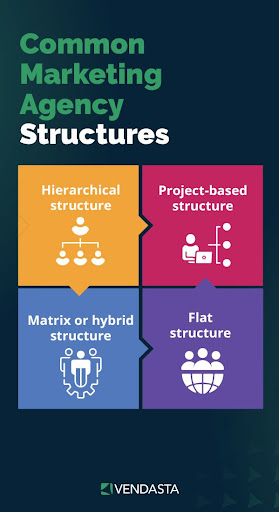Common Marketing Agency Structures to Build an Organizational Blueprint
For your business to operate like a well-oiled machine, you need to choose the right marketing agency structure. Even if you have excellent tools and solutions in your portfolio and top-notch customer relationships, your agency will suffer without the right structure to organize how work gets done. As you grow from a startup agency to an established leader, your digital marketing department structure will become even more integral to your ability to deliver an exceptional experience at scale.
Learn to attract, hire and onboard top talent to fulfill the needs of your growing agency. Get your copy of 'The agency’s guide to hiring digital talent' today!
If you want to effectively manage and coordinate your agency’s marketing activities, you’ve come to the right place. This blog post covers the major marketing agency structures, key departments and roles, the importance of the right structure, and how to structure your digital agency for maximum success.
Common Marketing Agency Structures
Marketing agencies typically implement a structure in one of the following ways:
- Hierarchical structure
- Project-based structure
- Matrix structure
- Flat structure
Let’s take a look at the unique characteristics, advantages, and suitability of each for different agencies.
Hierarchical structure

Hierarchical structures are, as the name implies, based on clearly defined hierarchies with each role reporting to a superior and one executive, typically the agency owner, at the top of the structure.
Also known as the traditional model, this organizational structure is common across many industries, not just the agency world. Thanks to its pyramid-like scheme, there’s a clear chain of command that gives all members of an agency clarity on their responsibilities and those of colleagues.
In a hierarchical structure, agency managers might be assigned by function (ie. business development, creative, digital marketing), geography, or niche if the agency functions in multiple niches.
Pros:
- An unambiguous chain of command results in a straightforward decision-making process.
- Specialization by function, geography, or niche allows for expertise in a specific area.
- Well-defined roles facilitate accountability for all team members, with responsibility increasing for roles higher up the hierarchy.
Cons:
- Potential inertia in larger structures due to decisions having to go through multiple levels of approval.
- Limited communication between different management areas.
- May limit creativity due to a rigid, bureaucratic work environment.
Project-based structure
In a project-based structure, also sometimes referred to as a pod structure, multifunctional teams form around specific clients or projects. Instead of having a single digital marketing team delivering services to all agency clients, each project group or pod will have a digital marketing lead or several dedicated digital marketing roles. In other words, every group is largely self-sufficient. Projects might be defined as individual large clients, groups of clients, or one-off projects.
Pros:
- Adaptability to client needs as agencies can put together appropriate teams for every client, directly responding to the demands of each project.
- Cross-functional innovation as groups are made of people with diverse roles, fostering communication, innovation, and creativity.
- Streamlined operations as groups can move fast, improving client satisfaction, since they don’t need to worry about checking every decision with a higher-up.
Cons:
- Potential inertia in larger structures due to decisions having to go through multiple levels of approval.
- Siloing due to limited communication between different groups.
- Fragmentation of expertise due to experts being siloed off from other groups.
Matrix or hybrid structure
Some agencies choose a customized marketing agency structure combining aspects of the two models we’ve discussed. With this approach, agencies still assign managers by function, who have a chain of team members reporting to them. However, instead of just reporting to a manager, staff break out into pod groups to work on projects or client accounts.
Pros:
- Highly flexible since agencies can shift resources between pods and traditional hierarchies as needed.
- Promotes communication since, unlike a project-based structure, there is little risk of siloing.
- Promotes development of agency skills for team members who may find themselves working on diverse projects with colleagues in different departments.
Cons:
- An unclear chain of command can lead to confusion and too many reporting demands.
- Complex structure which, from a management perspective, may require more work to oversee.
- Client confusion resulting from too many touch points within the agency.
Flat structure
In a flat digital marketing agency team structure, traditional layers of hierarchy are minimized or removed altogether. Decision-making authority is decentralized, and employees have maximal autonomy to work individually and collaborate as needed.
Pros:
- Promotes team members to exercise agency and take on more responsibilities.
- Promotes a collaborative environment thanks to an open work culture.
- Responds to client needs due to the ability to be nimble.
Cons:
- It limits specialization which can lead to confusion and too many reporting demands.
- Unconducive to scaling agencies that benefit from specialization.
- Role confusion for team members, who may prefer a clear career path and promotional opportunities.
Important departments needed for an agency
Whichever marketing agency structure you choose when starting your company, you’ll need to create some departments to go along with it. The purpose of departments is to ensure a well-coordinated and efficient operation that aligns with your chosen structure. Let’s take a look at the key marketing departments essential for a well-functioning marketing agency:
Marketing strategy department
The role of the strategy department is to devise marketing plans aligned with client objectives and industry trends. Team members in this department might spend time on market research, target audience identification, competitive analysis, and strategic planning for client accounts. They might also work on broader digital marketing strategies for the agency which can be applied to a wide variety of clients.
Creative department
Creative teams take marketing strategies and transform them into scroll-stopping, conversion-boosting, and visually appealing content. They work on everything from graphic design and copywriting to branding projects, photography, and video.
Digital marketing department
Digital marketing teams execute the plans created by the marketing strategy department, often using the creative assets made in the creative department. Their goal is to help clients meet business goals through digital marketing tasks like search engine optimization (SEO), website creation, social media management, pay-per-click advertising (PPC), and more.
Business development and account management department
This department focuses on lead generation—the business development portion—and liaises between clients and the agency. The most important functions of this department are finding clients and generating sales, client communication, project coordination, and management of client relationships.
Analytics department
Digital marketing generates a ton of data, and the role of the analytics department is to measure, analyze, and interpret it to gauge the performance of campaigns. These insights are rolled into reports and recommendations for data-informed decision-making.
Important roles and positions in a marketing agency structure
Top talent can help you reach your agency goals faster. Key positions in a digital marketing agency organizational structure include:
- Chief executive officer (CEO): The CEO holds the top leadership role, which is key to setting the overall strategic direction of the agency. Responsibilities of CEOs include leadership, decision-making, and ensuring the agency's financial health and growth.
- Chief Marketing Officer (CMO): CMOs lead the marketing strategy department within digital agencies. They are often involved in developing marketing plans, identifying trends, and ensuring alignment of strategies with client objectives.
- Department heads: This role is essential to the hierarchical digital marketing agency team structure discussed above, but can also fit into the other structures. Department heads lead the departments discussed in the previous section, overseeing department operations, leading their teams, and implementing long-term initiatives.
- Project managers (PMs): Tasked with ensuring successful project execution, PMs take on responsibilities like planning strategies for specific clients, coordinating between different departments, and facilitating communication to make sure client goals are met.
- Account managers: Serving as the main point of contact between clients and the agency, account managers handle direct client communication and work with project managers to ensure client satisfaction.
- Digital marketers: Marketers create and manage digital campaigns for clients.
- Creative content creators: People in this role create content based on client goals and inputs which can be used in digital marketing campaigns.
Want some tips on building a winning team? Check out this episode of the Conquer Local Podcast:
Why structure is important in a marketing agency
A well-defined marketing agency structure is non-negotiable for agencies that scale beyond solo operations. It ensures effective communication, collaboration, and a streamlined workflow, all of which are required to exceed client expectations consistently and at scale.
Having the right digital marketing agency organizational structure isn’t just valuable from the client’s perspective: if you want a satisfied team with high morale, a well-structured organization is a must. Even independent workers benefit from knowing what their roles and expectations are so they can feel purposeful in their work.
How to structure a marketing department
When creating your marketing agency team structure, it’s important to be aware of the considerations that might impact your choice, especially if you’re starting with no experience.
Assess your agency size, goals, and client requirements
Are you a two-person agency or do you need to organize dozens of team members? The smaller you are, the more you can get away with a flat structure.
Your agency goals may also influence your choice. For a smaller agency with a limited number of team members, a flat structure might be more effective, allowing for quick decision-making and flexibility. If you have a larger team or complex goals, a hierarchical or matrix structure could provide the necessary organization and specialization.
Your agency niche or the specific requirements of your clients should inform your marketing agency structure, too. Some types of clients may require the specialized support of a project-based structure. Others may be well-served by a more generalized approach, which can be delivered through a hierarchical structure.
Ace the implementation
When implementing your new digital marketing department structure, follow these steps:
- Get organized: Start by organizing specialized teams for marketing strategy, creative, digital marketing, analytics, and any other departments appropriate for your agency.
- Be clear: Unambiguously define roles and responsibilities to ensure each team member understands their specific contributions.
- Communicate: Establish transparent communication channels internally and with clients to promote collaboration.
- Iterate: Regularly review and adapt your structure for agility.


